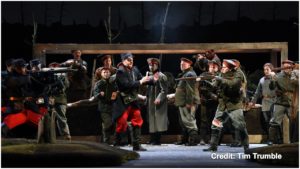
Arizona Opera 2018-19 Review: Silent Night
Kevin Puts & Mark Campbell’s Masterpiece Brings Issues Of the Past Into Present Times
By Maria NockinFor the winter holiday season of 2018, San Diego Opera presented “All Is Calm: the Christmas Truce of 1914,” which has a libretto by Peter Rothstein with musical arrangements by Erick Lichte and Timothy C. Takach. I expected something rather similar when I entered Tucson Music Hall on March 9 for Mark Campbell and Kevin Puts’ “Silent Night,” because its story is based on the same 1914 wartime incident.
During a late December in World War I, French, German and Scottish troops found it possible to declare an unofficial “truce” and celebrate a common holiday in brotherhood. The story has been told in several other artistic formats including the French film “Joyeux Noël,” on which Campbell based his libretto.
Going Back in Time
“Silent Night,” Puts’ first opera, received its premiere at Minnesota opera in 2011 and won a Pulitzer Prize the following year. Puts and Campbell’s beautifully constructed work introduces its main characters well before the expected cessation of hostilities and it takes the dramatic situation of the “truce” to bring the story to its inevitable military conclusion. In this opera, the composer and librettist have created recognizable individual characters that drew the audience into the story to provide an entertaining and enriching experience.
The Prologue opened with an 18th century style duet sung at a pre-war Berlin opera house by Andrew Bidlack as Nicholas Sprink, and Julie Adams as Anna Sorensen. A lyric tenor, Bidlack sang with fluidity and flexibility. Adams, however, sang with a hard-edged dramatic sound that did not allow her sound to blend with Bidlack’s.
When the German Army drafted Sprink, we were transported to Scotland for the enlistment of the Dale brothers, sung most effectively by heroic tenor Bille Bruley and lyric baritone Timothy Murray. Then we went to France for the departure of Lieutenant Audebert whose wife was pregnant with their first child.
Each aspect of the story continued to involve personalities and individual tales from all three countries.
Moving the Action
Stage director Michael Shell never let the tension lag and he constantly reminded the audience both audibly and visibly of the constant danger experienced by those serving in the front lines..When the singing actors were in the war zone, Scenic Designer Steven C. Kemp encased each country’s soldiers in a conveyance symbolizing a trench that its inhabitants pushed to various positions on the stage. Its upper board represented ground level, so anyone seen with his head above it was visible in the trench and likely to be shot.
Designer Driscoll Otto’s lighting added immeasurably to the situational effects of war. Costume Designer Melissa Torchia dressed each army with defining colors and designs that made their soldiers easily identifiable. Because of the tensions exacerbated by the situation, Fight Director Andrea Robertson staged a great many violent altercations, both between armies and within each company.
Puts music ranged from poignant single instrument folk tunes for harmonica or bagpipe to magnificent fully orchestrated vocal solo and choral pieces accompanied by 50 instruments playing in multi-layered, complex harmony.
Conductor Joseph Mechavich maintained varied tempi that allowed the singers enough leeway to breathe in reasonable comfort as he led the Arizona Opera Orchestra in Puts’ uniquely individual, vibrantly colored musical tapestry.
Although this intricately woven music was new for the instrumentalists, the Arizona Opera Orchestra played it with elegant style and a great deal of panache. Henri Venanzi’s chorus is always spot-on with their intonation and harmonies. This performance was no exception. Puts and Campbell gave us a wonderful piece to excerpt as an example of their work in their iconic arrangement of St. Francis prayer, “Lord make me an instrument of thy peace.” I’m sure we will hear that separately.
Wide Array of Personalities
Joseph Lattanzi was a long-suffering Audebert who could have been any mother’s son trying to contend with army regulations. His haunting voice was memorable. Kyle Albertson was an officious Horstmayer who had not yet realized the ramifications German anti-Semitism would have for him and his family. Corey Bix was a vocally commanding Kronprinz and Seth Kersisnik an insistent German General.
Scotsmen, Ricardo Rivera as Lieutenant Gordon and Jarrett Porter as Father Palmer, added measurably to the picture as did British Major Brandon Morales. Chad Sloan was a heartrending Ponchel and Katherine Beck a memorable Madeleine Audebert, while Nathan Stark was a no-nonsense French General.
One question in my mind is whether or not “Silent Night” is a holiday piece that will eventually be restricted to December performances. “All is Calm” is definitely a Christmas opera. Musically, “Silent Night” can stand on its own in any season, but its story does have a special affinity to the Christmas season. Both works take strong anti-war stands but they also honor the individuals who fight and die in an effort to serve their various countries.
“Silent Night” was a vision of a Christmas long past but its issues are unfortunately ongoing. It is still the generals who send conscripted men to fight, get wounded both mentally and physically, and sometimes die for their countries. Rulers and law makers merely look on and comment.
Thank goodness art is also unchanging, and just as there have been great composers in past centuries, today’s composers also give us valuable new operas to enjoy.


